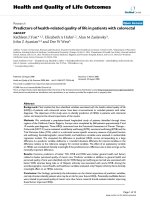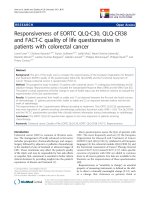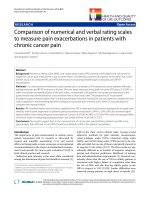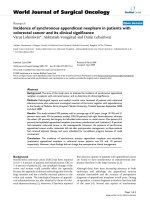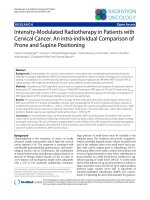Causes of death in patients with extranodal cancer of unknown primary: Searching for the primary site
Bạn đang xem bản rút gọn của tài liệu. Xem và tải ngay bản đầy đủ của tài liệu tại đây (461.63 KB, 8 trang )
Riihimäki et al. BMC Cancer 2014, 14:439
/>
RESEARCH ARTICLE
Open Access
Causes of death in patients with extranodal
cancer of unknown primary: searching for the
primary site
Matias Riihimäki1,2*, Akseli Hemminki3, Kristina Sundquist2,4 and Kari Hemminki1,2
Abstract
Background: Cancer of unknown primary (CUP) is a fatal cancer, accounting for 3–5% of all diagnosed cancers.
Finding the primary site is important for therapeutic choices and we believe that the organ which is designated
as the cause of death may give clues about the primary site.
Methods: A total of 20,570 patients with CUP were identified from the Swedish Family-Cancer Database. Causes of
death – as reported in the death certificate - were investigated, analyzing reported metastatic sites and histological
subtypes separately. Survival was compared with metastatic cancer with a known primary tumor.
Results: An organ-specific cancer could be identified as a cause of death in approximately 60% of all CUP patients
with adenocarcinoma or undifferentiated histology. In adenocarcinoma, lung cancer was the most frequent cause
of death (20%), followed by pancreatic cancer (14%), and ovarian cancer (11%). Lung cancer was the most common
cause of death in patients with CUP metastases diagnosed in the nervous system (69%), respiratory system (53%),
and bone (47%), whereas ovarian cancer was the most common cause of death when CUP was diagnosed in the
pelvis (47%) or the peritoneum (32%). In CUP diagnosed in the liver, liver and pancreatic cancers accounted for
26% and 22% of deaths, respectively. Also in squamous cell CUP, lung cancer was the most common cause of
death (45%).
Conclusions: According to the causes of death, the primary site appeared frequently to be either the organ where
CUP metastases were diagnosed or an organ which may be traced through the known metastatic patterns of
different cancer types.
Keywords: Cancer of unknown primary, CUP, Cause of death
Background
Cancer of unknown primary (CUP) is a group of cancers,
frequently cited to account for 3–5% of newly diagnosed
cancers [1-5]. Despite its high incidence, very little is known
about this challenging entity of cancers. Most patients with
CUP have a dismal prognosis: survival estimates are often
in the magnitude of a few months [6,7], although it may be
longer in hospital-based studies with selected populations
[8,9]. Especially, CUP with metastases in the liver has a
poor prognosis, with patients only surviving a median of
two months [8-12]. However, some favorable subsets have
* Correspondence:
1
Division of Molecular Genetic Epidemiology, German Cancer Research
Centre (DKFZ), Heidelberg 69120, Germany
2
Center for Primary Health Care Research, Lund University, Malmö, Sweden
Full list of author information is available at the end of the article
been described, such as neuroendocrine CUP, and CUP
limited to lymph nodes [2,3,9,13]. CUP poses a challenge
for the treating physician, because cancer treatment is
typically planned based on the primary tumor; therefore,
upon detection of a metastasis, a wide diagnostic workup
is initiated to detect the primary site [2,3,9,14-17]. Despite
recent advances in diagnostic modalities, including imaging techniques, expression profiling, and immunohistochemical methods, not all primary tumors are found, and
some cancers remain cancers of unknown primary. Ultimately, in some cases the primary site may be detected by
autopsy, and is then often situated in the lungs or gastrointestinal system [13,14]. However, in some cases no primary is found, presumably reflecting the immunological
© 2014 Riihimäki et al.; licensee BioMed Central Ltd. This is an Open Access article distributed under the terms of the Creative
Commons Attribution License ( which permits unrestricted use, distribution, and
reproduction in any medium, provided the original work is properly credited. The Creative Commons Public Domain
Dedication waiver ( applies to the data made available in this article,
unless otherwise stated.
Riihimäki et al. BMC Cancer 2014, 14:439
/>
eradication of the original tumor subsequent to shedding
of metastases.
Although being a diverse group of cancers, some clinical
features distinguish CUP [2,18]. The primary tumor has
often regressed, or may even have disappeared. Furthermore, patients with CUP typically have metastases, and
the disease is often characterized by resistance to chemotherapy. CUP often displays biological features, such as
aneuploidy [1,3]. Furthermore, some metastasis-related
genes are frequently overexpressed, e.g. c-Myc [1], MET
[17], MMPs [19], and VEGF [18]. In family studies, CUP
could be linked with several other cancers, e.g. liver, lung,
pancreas, and ovaries [4,5]. Another approach has been to
investigate the etiology of CUP utilizing death certificates
of patients with CUP; indeed cancers of the lung, liver,
pancreas, and ovaries are common causes of death after
diagnosis of CUP [5,20]. In CUP limited to lymph nodes,
lung cancer is the most common specified cancer in death
certificates, especially in CUP detected in thoracic lymph
nodes, which supports the notion that the primary cancer
originates in the lung [21].
In the present study, we investigated the causes of death
in extranodal CUP, depending on the location of CUP
metastases at diagnosis. Different histological subtypes
were analyzed separately (adenocarcinoma/undifferentiated cancer, squamous cell cancer, and melanoma). We
allow that the tumor resulting in CUP diagnosis may in
fact be different from the original primary tumor, since
when CUP is diagnosed, the primary is by definition not
known. However, our hypothesis is that the tumor causing
death may in fact represent the original primary tumor
which could not be originally detected with the available
imaging methods. Nevertheless, the primary may have
persisted and ultimately resulted in death. We assumed
that the known metastatic pathways of primary cancers
also apply to the metastatic spreading of CUP. To dissect
our hypothesis, the survival kinetics of patients with CUP
was compared with the survival of patients with known
primaries.
Methods
The dataset used in this study was obtained from the most
recent update of the Swedish Family-Cancer Database
(FCD), which is a national research database located at the
Center for Primary Health Care Research, Malmö, Sweden.
The FCD contains, e.g., cancer data from the Swedish
Cancer Registry and death statistics from the Cause of
Death Registry [22], and has been used in several population-based studies on CUP [4,5,9,11,12,21,23]. All cancer
cases diagnosed from 1958 through the end of 2010 are
included. The Swedish Cancer Registry, which is based on
the compulsory notification of cancer cases and the completeness of cancer registration has been approximated to
be over 90% [24].
Page 2 of 8
CUP cases were identified by their ICD-codes (International Classification of Disease), as reported in the
Cancer Register. The Cancer Register has used ICD-7
since 1958, ICD-9 since 1987, ICD-O/2 since 1993, and
ICD-O/3 since 2005. All subsequent versions in the Cancer Register are also translated to older versions, enabling
comparisons over time. ICD-9 coding, and later versions,
allow identification of the site of CUP metastases. The
Cause of Death Registry used ICD-9 coding between 1987
and 1996, and ICD-10 coding since 1997 [22]. Accordingly, the follow-up time was 1987 through 2010. SAS
software was used for statistical analyses. Kaplan Meier
plots were generated with PROC LIFETEST (SAS Version
9.3; SAS Institute, Cary, NC).
The locations of CUP metastases were identified by
their ICD-9 code: respiratory system (195.1, 197.0-3),
liver (197.7), peritoneum/retroperitoneum (195.2, 197.6),
nervous system (198.3-4), bone (198.5), pelvis (195.3),
other specified (195.0, 4, 5, 8, 9; 198.0-2, 6–9), and “unspecific cup/CUP C80” (199). ICD-9 and −10 codes 199 and
C80 correspond to unspecified CUP location, both in the
Cancer Registry and the Cause of Death Registry. Primary
cancer sites were identified by their ICD-7 codes, and
histological subtypes were identified by their WHO/HS/
CANC/24.1 (pad) codes. Previous reports have shown that
adenocarcinoma and undifferentiated histology are similar,
thus these two histological types were analyzed together
[9]. Unspecified and other histological subtypes than adenocarcinoma/undifferentiated, squamous cell, and melanoma were not included in the analyses.
Results
A total of 28,419 CUP patients diagnosed between 1987
and 2010 were identified from the FCD. Of these, 26,811
(93%) died during the study period. Adenocarcinoma
was the most common histology (14,947 cases [55.%]),
followed by undifferentiated (4143 cases [15.5%]), squamous cell (773 cases [2.9%]), and melanoma (707 cases
[2.6%]). Unspecified histology (5185 cases [19.3%]) and
other specified histological subtypes (1,056 cases [3.9%])
were omitted from analyses.
In Table 1, the underlying causes of death in patients
with CUP (adenocarcinoma/undifferentiated) are displayed,
depending on the location of CUP metastases at diagnosis.
Overall, of all specified cancer causes of death, lung cancer
was the most common (20%), followed by pancreatic
cancer (14%), and ovarian cancer (11%). Substantial differences could be noted in causes of death between different
CUP sites. The most common specific CUP location was
the liver. Of all specified cancer causes of death, the most
common for CUP of liver were cancer of liver (26%), pancreas (22%), colorectum (13%), and biliary system (13%).
In CUP of the peritoneum, the causes of death were different: ovarian cancer (32%), pancreatic cancer (16%), and
Riihimäki et al. BMC Cancer 2014, 14:439
/>
Page 3 of 8
Table 1 Causes of death (from the Swedish cause of death registry) in patients with CUP (adenocarcinoma and
undifferentiated cancer) depending on site in the Swedish cancer register
Location of CUP
Cause of death
Liver
Peritoneum
Lung
189
8%
29
Pancreas
551
22%
Ovaries
25
1%
Colorectum
330
Liver
649
Biliary system
310
Ill-defined
gastro-intestinal
202
Mediastinum
Respiratory
system
Bone
Pelvis
3
Nervous
system
Other
specified
C80/199
All
1%
558
53%
217
47%
1%
194
69%
184
27%
934
24%
2308
20%
371
16%
31
3%
19
4%
765
32%
33
3%
1
0%
4
1%
2
1%
66
10%
523
13%
1567
14%
160
47%
0
0%
34
5%
284
7%
1302
11%
13%
291
12%
17
2%
17
4%
26%
56
2%
13
1%
14
3%
26
8%
9
3%
82
12%
362
9%
1134
10%
2
1%
0
0%
10
1%
353
9%
1097
9%
13%
161
7%
7
1%
5
1%
0
0
0
0%
31
5%
285
7%
799
7%
8%
154
6%
13
1%
12
3%
4
1%
1
0%
33
5%
219
6%
638
6%
1
0%
13
1%
272
26%
3
1%
1
0%
4
1%
10
1%
114
3%
418
4%
Urinary system
28
1%
27
1%
22
2%
60
13%
12
4%
13
5%
51
7%
139
4%
352
3%
Stomach
50
2%
120
5%
12
1%
4
1%
3
1%
2
1%
38
6%
94
2%
323
3%
Peritoneum
5
0%
160
7%
5
0%
0
0%
10
3%
0
0%
6
1%
76
2%
262
2%
Breast
16
1%
6
0%
11
1%
24
5%
1
0%
3
1%
33
5%
70
2%
164
1%
Prostate
3
0%
4
0%
2
0%
34
7%
4
1%
6
2%
11
2%
76
2%
140
1%
Other cancer
100
4%
223
9%
58
6%
52
11%
108
32%
48
17%
92
14%
363
9%
1044
9%
Any specified
cancer
2459 100%
2380
100%
1054
100% 462 100% 338 100% 282 100%
681
100% 3892 100% 11548 100%
CUP C80
1456
1456
313
398
122
106
287
2110
6248
Non-cancer
175
175
122
85
41
32
107
557
1294
Total
4090
4011
1489
945
501
420
1075
6559
18330
CUP = Cancer of unknown primary. C80/199 = CUP with unspecified location. The most common cause of death is bolded.
colorectal cancer (12%). Lung cancer was the most frequently mentioned cause of death when CUP was diagnosed in the bone (47%), the nervous system (69%), and
the respiratory system (53%), but not as common in CUP
of the peritoneum (1%), and the pelvis (1%). Ovarian cancer was also a common cause of death when CUP was diagnosed in the pelvis (47%) and peritoneum (32%). The
group “other cancer” was large in CUP of the nervous
system and pelvis. This group constitutes e.g. brain
tumors, which was a common death cause in CUP of
the nervous system (23 cases, 8%), and female genital
cancer, which was a common cause of death in CUP of
pelvis (85 cases, 25%).
In Table 2, causes of death in patients with squamous
cell CUP are displayed. Of all specified cancer causes of
death, lung cancer (45%) was the most common. Lung
cancer was the most common cause of death when CUP
was diagnosed in the nervous system (90%), bone (77%),
and respiratory system (62%). Upper aerodigestive tract
cancer accounted for 32% of deaths in patients who had
CUP diagnosed in the head. Notably, the proportion of
non-cancer causes of death was substantially higher in
squamous cell CUP than in adenocarcinoma/undifferentiated CUP. If the histological subtype of CUP was
melanoma (707 cases, not displayed), the cause of death
was melanoma in 577 (81.6%) of cases, other cancer than
melanoma in 57 (8.1%), and unspecified CUP in 18 (2.5%)
cases. 55 patients (7.8%) died from non-cancer causes.
Survival in CUP was compared with survival in cancer
with known primaries. In Figure 1, survival in CUP patients with lung cancer as the death cause was compared
with primary lung cancer, metastatic (TNM stage M1)
and non-metastatic (TNM stage M0) at diagnosis. The
upper panel depicts patients with adenocarcinoma and
undifferentiated histology. Four CUP sites were analyzed:
liver, nervous system, bone, and respiratory system. Survival was similar in CUP and in stage M1 lung cancer,
although CUP of liver featured the worst prognosis. In
the lower panel, analysis was restricted to squamous cell
histology. Survival in patients with CUP was slightly
worse than in stage M1 lung cancer.
In Figure 2, survival in CUP patients with liver (upper
panel) and pancreatic cancer (lower panel) as cause of
death was compared with metastatic (M1) and non-metastatic (M0) pancreatic cancer. Survival is very similar in
both CUP of the liver and the peritoneum, compared with
M1 pancreatic cancer. Liver cancer deaths in patients with
CUP of the liver were compared with M1 and M0 liver
cancer. Again, survival was very similar in both CUP and
metastatic cancer.
Riihimäki et al. BMC Cancer 2014, 14:439
/>
Page 4 of 8
Table 2 Causes of death (from the Swedish cause of death registry) in patients with CUP (Squamous cell cancer) in the
Swedish cancer registry
Site of CUP
Cause of death
Lung
Head
8
24%
Respiratory
system
37
62%
Liver
Peritoneum
Bone
Pelvis
Nervous
system
Other
specified
199/C80
11 29%
2
9%
17 77%
0
0%
19 90% 15 38%
91
All
48% 200 45%
Upper aerodigestive 11 32%
1
2%
1
3%
0
0%
0
0%
0
0%
0
0%
4
10%
15
8%
32
7%
Mediastinum
0%
16
27%
0
0%
0
0%
0
0%
0
0%
0
0%
0
0%
7
4%
23
5%
0
Urinary system
1
3%
0
0%
0
0%
2
9%
1
5%
5
31%
0
0%
4
10%
9
5%
22
5%
Skin
5
15%
0
0%
1
3%
0
0%
3
14%
0
0%
0
0%
3
8%
7
4%
19
4%
Oesophagus
1
3%
2
3%
0
0%
0
0%
0
0%
0
0%
1
5%
3
8%
10
5%
17
4%
Liver
0
0%
1
2%
10
26%
0
0%
0
0%
0
0%
0
0%
0
0%
6
3%
17
4%
Pancreas
0
0%
1
2%
5
13%
3
13%
1
5%
0
0%
0
0%
1
3%
4
2%
15
3%
Biliary system
0
0%
0
0%
6
16%
2
9%
0
0%
0
0%
0
0%
0
0%
5
3%
13
3%
Other cancer
8
4
0%
11
69%
1
5%
10
25%
34
18%
84
19%
24%
2
3%
Any specified cancer 34 100%
60
100%
11%
14
61%
0
38 100%
23
100%
22 100% 16 100% 21 100% 40 100% 188 100% 442 100%
CUP C80
24
Non-cancer
21
10
27
23
15
13
6
17
77
212
7
1
2
3
5
3
8
69
119
Total
80
77
66
48
40
34
30
65
334
773
CUP = Cancer of unknown primary. C80/199 = CUP with unspecified location. The most common cause of death is bolded.
Discussion
In the present study, we investigated causes of death in
CUP patients. Distinct patterns could be seen in the
causes of death depending on the location of CUP
metastases at diagnosis. Overall, lung cancer was the
most common cause of death when the initial site of
CUP (adenocarcinoma/undifferentiated) was the nervous
system (69%), respiratory system (53%), or bone (47%).
On the other hand, ovarian cancer was a common cause
after diagnosis of CUP in the pelvis (47%) and peritoneum
(32%). We suggest that the cause of death, as determined
in the death certificate, at least for some CUP patients
point to the origin of primary tumor. For CUP diagnosed
in the respiratory system lung and mediastinal cancers
accounted for 79% of specified cancer deaths and survival
curves were identical with primary metastatic lung cancer,
which is compatible with the notion that the primary was
a lung cancer that evaded detection during diagnostic
workup. Similarly, for CUP located in the liver at diagnosis
liver/pancreas/biliary system deaths accounted for 61% of
all specific cancer deaths and survival kinetics were identical with metastatic liver cancer. Lung cancer deaths in patients whose CUP was located in the nervous system and
bone is consistent with known metastatic pathways, as are
ovarian cancer deaths with CUP locations of the peritoneum and pelvis. Thus we suggest that CUP location at
diagnosis should direct a careful search of the primary to
the likely sites defined here. This also has implications
with regard to therapeutic choices.
Many of the patterns seen may be attributed to the
known metastatic pathways [25,26]. For example, ovarian
cancer frequently metastasizes within the pelvis and the
peritoneum. Pancreatic cancer frequently metastasizes to
the liver. Lung cancer often metastasizes within the respiratory organs, or to the nervous system and bone. Kidney
cancer (included in “urinary system”) is also known to
metastasize to the skeletal system. Considering the high
incidence of bone metastases among breast and prostate cancer patients [27], it may be surprising to note
that breast and prostate cancer are relatively uncommon
causes of death in patients with CUP of bone, compared
with lung cancer. There may be many reasons for this
finding. The development of bone metastases is influenced by how long the patient lives with the tumor [27],
and the primary tumor should be detected during that
time. Also, because breast and prostate cancer are relatively easily detected by mammography and PSA tests, is
seems reasonable to assume that many such tumors
should be correctly diagnosed, and therefore not noted as
CUP. Our results rely heavily on the accuracy of death
certificates in Sweden. Generally, cause of death coding in Sweden is considered to be reliable, especially
if the underlying cause of death is cancer [11,12,21].
Most cancer deaths occur in hospitals, and regardless
of the location of death regulations specify that the
issuer of the death certificate was either involved in
the treatment of the patient, or profoundly educated
themselves with the medical record. In unclear cases
autopsy has been traditionally employed. Either way,
the issuer of the death certificate has intimate knowledge
of the patient’s medical history including the different
phases of the malignancy.
Riihimäki et al. BMC Cancer 2014, 14:439
/>
Page 5 of 8
Figure 1 Kaplan-Meier curves for metastatic (M1) and non-metastatic (M0) non-CUP lung cancer patients, compared with lung cancer
deaths (according to the death certificate) of CUP patients with CUP diagnosed in specific locations (Nervous system, respiratory
system, liver, bone). The upper panel (A) includes adenocarcinoma only, and the lower panel (B) depicts squamous cell cancer.
Notifications of cancer to the Swedish Cancer Registry
require two separate reports, one by a clinician and the
other by a pathologist. CUP is reported if no primary
tumor is found after adequate diagnostic work-up. If a
primary site is found later, CUP diagnosis may be changed
to the true primary [21]. Death registration is a completely
independent process through the Causes of Death Register. The data are reported by a medically qualified death
registrar who is usually well aware of the clinical course of
the disease because for over 90% of cancer deaths examination at hospital prior to death was the basis on which the
death certificate was issued [12]. CUP offers a unique
opportunity to monitor the sequence of events from the
hidden primaries to fatal organ metastases because death
certificates give the site of organ metastasis as the cause of
death even if histopathology indicates CUP. This practice
deviates from that of any other cancer for which the primary cancer is given as the cause of death. Autopsy data
are not used to change CUP diagnosis and nor would they
be helpful because autopsy rates in Sweden have steadily
declined, from 25% in 1987 to 7% in 2010 (women), and
from 33% to 16% (men) [28]. Furthermore, the rate is
lower in cancer patients and elderly. Previous family
studies have shown that the cause of death in patients
with CUP often is the same that is diagnosed in a family
member [4,5].
Two classic theories are often used to explain the
metastatic process: the seed and soil hypothesis, and the
Riihimäki et al. BMC Cancer 2014, 14:439
/>
Page 6 of 8
Figure 2 Kaplan-Meier curves for metastatic (M1) and non-metastatic (M0) non-CUP liver (A) and pancreatic (B) cancer patients,
comparing to survival of patients with an initial diagnosis of CUP, eventually dying of liver or pancreatic cancer, according to their
death certificates.
anatomical/mechanical hypothesis [29]. The seed and
soil hypothesis stipulates that the interaction between
the tumor cell (“seed”) and the target organ (“soil”) is
important for the development of metastases. This theory
partly explains why some malignancies tend to metastasize to the same organ where the tumor originated, or to
selected target organs, e.g. breast cancer to the other
breast or to the brain, while prostate cancer is often multifocal locally or metastatic to the bone. Also, the anatomical/mechanical hypothesis has shown merit in explaining
metastatic patterns, and can be presumed to be important
in CUP. Due to the portal venous system, it is natural that
the primary cancer in CUP of liver may often be found
within the gastro-intestinal system. In nodal CUP,
anatomical factors may also play an important role
[21]. In CUP of lymph nodes in the head, neck, or
thoracic region, the most common cause of death was
lung cancer, whereas in axillary lymph node CUP, it was
breast cancer. Although the present results imply that a
primary tumor may be found in patients with CUP, it is
important to remember that initiating excessive diagnostic
maneuvers is not necessarily the best strategy for these
patients.
Although the primary site in CUP may be explained
through the metastatic patterns of common cancers, some
evidence points out that the primary tumor in CUP might
Riihimäki et al. BMC Cancer 2014, 14:439
/>
in fact reside in the same organ as CUP, or even be the
primary tumor itself. Different explanations supporting
this view have been presented in previous studies. If the
CUP in fact is the primary cancer, the tumor may have
undergone massive phenotypical changes, seeming to be
metastatic tissue, whereby it is not diagnosed as a primary
tumor [5]. Alternatively, if the hidden primary tumor in
CUP has resided in the same organ as the metastasis,
it may have regressed to an undetectable size, or even
have been eradicated by immune surveillance [2,18].
In practice, this has manifested in two ways in previous
epidemiological research: 1) the cause of death in many
patients with CUP may frequently be scored as cancer of
the same organ where CUP was detected [12,20], and 2)
that CUP confers an increased risk of a second cancer
diagnosis at some locations, including the lung, ovaries,
and kidney, all of them common primary sites for
metastases [23].
Conclusions
We have investigated the causes of death in patients with
CUP with the aim to explore the origins of this challenging
disease. In approximately 60% of CUP patients, an organspecific tumor was listed as the underlying cause of death,
lung cancer being the most common. When CUP was localized to the nervous system, respiratory system and bone,
the primaries should be preferentially searched in the lung.
In medicine, therapy follows diagnosis and thus even if
primaries are not found, the aforementioned biological
notions have relevance for selecting a therapy for each
patient. When CUP is diagnosed in the peritoneum or pelvis., even in the primary site cannot be identified, the initiation therapy targeting ovarian cancer could be considered
[2]. Although we provide some insight to the conundrum
CUP, further etiological research is motivated. Many patients with CUP are however elderly, and one must weigh
the possible harmful effects of a prolonged diagnostic
workup in these patients, especially if therapy is unlikely to
result from a more accurate diagnosis [30]. However, in
modern oncology, an increasing number of options are
available to oncologists and thus the possibility of optimal
diagnosis should not be overlooked, as some effective therapies can be administered with low toxicity.
Ethical approval
This study was approved by the ethical committee at
Lund University, Sweden.
Competing interests
The authors declare that they have no competing interests.
Authors’ contributions
KS provided the data. MR and KH designed the study. MR, AH, KS, and KH
interpreted the results. MR drafted the manuscript. All authors helped write
and critically reviewed the manuscript. All authors read and approved the
final manuscript.
Page 7 of 8
Acknowledgements
This work was supported by the German Cancer Aid. The funding sources
had no role in the design or interpretation of the study.
Author details
1
Division of Molecular Genetic Epidemiology, German Cancer Research
Centre (DKFZ), Heidelberg 69120, Germany. 2Center for Primary Health Care
Research, Lund University, Malmö, Sweden. 3Cancer Gene Therapy Group,
Transplantation Laboratory & Department of Pathology, Haartman Institute,
University of Helsinki, Helsinki 00290, Finland. 4Stanford Prevention Research
Center, Stanford University School of Medicine, Palo Alto, California, USA.
Received: 19 December 2013 Accepted: 6 June 2014
Published: 14 June 2014
References
1. Pentheroudakis G, Briasoulis E, Pavlidis N: Cancer of Unknown Primary Site:
Missing Primary or Missing Biology? Oncologist 2007, 12(4):418–425.
2. Fizazi K, Greco FA, Pavlidis N, Pentheroudakis G: Cancers of unknown
primary site: ESMO Clinical Practice Guidelines for diagnosis, treatment
and follow-up. Ann Oncol 2011, 22(6):vi64–vi68.
3. Pavlidis N, Pentheroudakis G: Cancer of unknown primary site.
Lancet 2012, 379(9824):1428–1435.
4. Hemminki K, Ji J, Sundquist J, Shu X: Familial risks in cancer of unknown
primary: tracking the primary sites. J Clin Oncol 2011, 29(4):435–440.
5. Hemminki K, Bevier M, Sundquist J, Hemminki A: Cancer of unknown
primary (CUP): does cause of death and family history implicate hidden
phenotypically changed primaries? Ann Oncol 2012, 23(10):2720–2724.
6. Levi F, Te V, Erler G, Randimbison L, La Vecchia C: Epidemiology of
unknown primary tumours. Eur J Cancer 2002, 38:1810–1812.
7. van de Wouw AJ, Janssen-Heijnen ML, Coebergh JW, Hillen HF:
Epidemiology of unknown primary tumours; incidence and
population-based survival of 1285 patients in Southeast Netherlands,
1984–1992. Eur J Cancer 2002, 38(3):409–413.
8. Hess KR, Abbruzzese MC, Lenzi R, Raber MN, Abbruzzese JL: Classification
and regression tree analysis of 1000 consecutive patients with unknown
primary carcinoma. Clin Cancer Res 1999, 5(11):3403–3410.
9. Hemminki K, Bevier M, Hemminki A, Sundquist J: Survival in cancer of
unknown primary site: population-based analysis by site and histology.
Ann Oncol 2012, 23(7):1854–1863.
10. Lazaridis G, Pentheroudakis G, Fountzilas G, Pavlidis N: Liver metastases
from cancer of unknown primary (CUPL): a retrospective analysis of
presentation, management and prognosis in 49 patients and systematic
review of the literature. Cancer Treat Rev 2008, 34(8):693–700.
11. Riihimäki M, Thomsen H, Hemminki A, Sundquist K, Hemminki K:
Comparison of survival of patients with metastases from known versus
unknown primaries: survival in metastatic cancer. BMC Cancer 2013,
13:36.
12. Hemminki K, Riihimaki M, Sundquist K, Hemminki A: Site-specific
survival rates for cancer of unknown primary according to location of
metastases. Int J Cancer 2013, 133:182–189.
13. Pentheroudakis G, Greco FA, Pavlidis N: Molecular assignment of tissue of
origin in cancer of unknown primary may not predict response to
therapy or outcome: A systematic literature review. Cancer Treat Rev 2009,
35(3):221–227.
14. Pentheroudakis G, Golfinopoulos V, Pavlidis N: Switching benchmarks in
cancer of unknown primary: from autopsy to microarray. Eur J Cancer
2007, 43(14):2026–2036.
15. Kwee TC, Kwee RM: Combined FDG-PET/CT for the detection of unknown
primary tumors: systematic review and meta-analysis. Eur Radiol 2009,
19(3):731–744.
16. Hainsworth JD, Rubin MS, Spigel DR, Boccia RV, Raby S, Quinn R, Greco FA:
Molecular gene expression profiling to predict the tissue of origin and
direct site-specific therapy in patients with carcinoma of unknown
primary site: a prospective trial of the Sarah Cannon research institute.
J Clin Oncol 2013, 31(2):217–223.
17. Stella G, Senetta R, Cassenti A, Ronco M, Cassoni P: Cancers of unknown
primary origin: current perspectives and future therapeutic strategies.
J Transl Med 2012, 10(1):12.
18. Karavasilis V, Malamou-Mitsi V, Briasoulis E, Tsanou E, Kitsou E, Kalofonos H,
Fountzilas G, Fotsis T, Pavlidis N: Angiogenesis in cancer of unknown
Riihimäki et al. BMC Cancer 2014, 14:439
/>
19.
20.
21.
22.
23.
24.
25.
26.
27.
28.
29.
30.
Page 8 of 8
primary: clinicopathological study of CD34, VEGF and TSP-1. BMC Cancer
2005, 5(1):25.
Karavasilis V, Malamou-Mitsi V, Briasoulis E, Tsanou E, Kitsou E, Kalofonos H,
Fountzilas G, Fotsis T, Pavlidis N: Matrix metalloproteinases in carcinoma
of unknown primary. Cancer 2005, 104(10):2282–2287.
Shu X, Sundquist K, Sundquist J, Hemminki K: Time trends in incidence,
causes of death, and survival of cancer of unknown primary in Sweden.
Eur J Cancer Prev 2012, 21(3):281–288.
Hemminki K, Bevier M, Sundquist J, Hemminki A: Site-specific cancer
deaths in cancer of unknown primary diagnosed with lymph node
metastasis may reveal hidden primaries. Int J Cancer 2013, 132(4):944–950.
Hemminki K, Ji J, Brandt A, Mousavi SM, Sundquist J: The Swedish
Family-Cancer Database 2009: prospects for histology-specific
and immigrant studies. Int J Cancer 2010, 126(10):2259–2267.
Shu X, Liu H, Ji J, Sundquist K, Forsti A, Sundquist J, Hemminki K:
Subsequent cancers in patients diagnosed with cancer of unknown
primary (CUP): etiological insights? Ann Oncol 2012, 23(1):269–275.
Ji J, Sundquist K, Sundquist J, Hemminki K: Comparability of cancer
identification among Death Registry, Cancer Registry and Hospital
Discharge Registry. Int J Cancer 2012, 131(9):2085–2093.
Hess KR, Varadhachary GR, Taylor SH, Wei W, Raber MN, Lenzi R, Abbruzzese
JL: Metastatic patterns in adenocarcinoma. Cancer 2006, 106(7):1624–1633.
Chen LL, Blumm N, Christakis NA, Barabasi AL, Deisboeck TS: Cancer
metastasis networks and the prediction of progression patterns.
Br J Cancer 2009, 101(5):749–758.
Mundy GR: Metastasis to bone: causes, consequences and therapeutic
opportunities. Nat Rev Cancer 2002, 2(8):584–593.
Socialstyrelsen: Dödsorsaker 2010 (Causes of death 2010). The Swedish
national Board of Health and Welfare. Accessible online at http://www.
socialstyrelsen.se/publikationer2011/2011-7-6.
Langley RR, Fidler IJ: The seed and soil hypothesis revisited-The role of
tumor-stroma interactions in metastasis to different organs. Int J Cancer
2011, 128(11):2527–2535.
Randen M, Rutqvist L-E, Johansson H: Cancer patients without a known
primary: Incidence and survival trends in Sweden 1960–2007.
Acta Oncologica 2009, 48(6):915–920.
doi:10.1186/1471-2407-14-439
Cite this article as: Riihimäki et al.: Causes of death in patients with
extranodal cancer of unknown primary: searching for the primary site.
BMC Cancer 2014 14:439.
Submit your next manuscript to BioMed Central
and take full advantage of:
• Convenient online submission
• Thorough peer review
• No space constraints or color figure charges
• Immediate publication on acceptance
• Inclusion in PubMed, CAS, Scopus and Google Scholar
• Research which is freely available for redistribution
Submit your manuscript at
www.biomedcentral.com/submit
